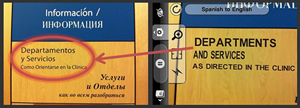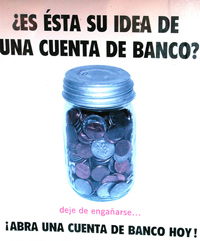
Source: Word Lens App - Augmented Reality Spanish to English -
Kaiser Hospital Sign, Robin M. Ashford, Flickr
Since there are about 20,000 Spanish-English cognates, it would be silly to try to memorize them all. However, because recognizing cognates is an excellent way to learn new words, let's talk about ways you can recognize some cognates when you are reading unfamiliar words.
There are three types of cognates that are relatively easy to recognize:
- Words that are spelled exactly the same
- Words that are spelled slightly differently
- Words that are spelled differently but sound similar

Source: Bogotrax - Fiesta y Politica,
Sterneck, Flickr
Since the first type of cognate, words that are spelled exactly the same, is the easiest to identify, let's spend some time identifying the two other types.
Words That Are Spelled Slightly Differently
Spelling patterns can help you identify Spanish cognates that are spelled slightly differently from the English word. Some of the most common patterns are reviewed below. Tip: When you come upon an unfamiliar word, read the sentence aloud. Often, hearing the word aloud will help you identify a cognate.
- A Spanish word with a final -e, -a, or -o is spelled similarly to the English word, except it has an -e, -a, and -o at the end of the word. Here are a few examples of Spanish words that end in -e, -a, and -o and their English cognates:
| Spanish | English |
|---|---|
| restaurante | restaurant |
| musica | music |
| grúpo | group |
When you’re reading and you encounter a word that looks like a Spanish word that you know, but it is missing an -a, -e, or -o, then it is probably a cognate. For example,
Denny recorded the results of his experiment every day.
If you are unfamiliar with the word experiment, but you know the Spanish word experimento, then you can conclude that experiment is the same as experimento.
- The English suffix -tion is the same as Spanish suffix -cion.
| Spanish | English |
|---|---|
| información | information |
| declaración | declaration |
- The English letters ph make the same sound as the letter f in Spanish. As you probably know, in English we pronounce the letters ph as [f]. So, when you read an unfamiliar English word that starts with or contains ph, think about Spanish words that sound the same but contain the letter f instead.
| Spanish | English |
|---|---|
| teléfono | telephone |
| foto | photo |
- Words that end in -io or -ia in Spanish are often cognates of words that end in -y in English.
| Spanish | English |
|---|---|
| historia | history |
| tragedia | tragedy |
| laboratorio | laboratory |

Source: Nueva York (306), engerunido, Flickr
Words That Are Spelled Differently but
Sound Similar
Reading aloud can be very helpful in recognizing Spanish-English cognates that are spelled differently but sound similar. Let’s take a look at a few words that fall into this category.
| Spanish | English |
|---|---|
| igual | equal |
| inicial | initial |
| hipótesis | hypothesis |
Now, let’s see if you can recognize the three different types of cognates. Complete the activity below by dragging and dropping each cognate pair into the correct column.
